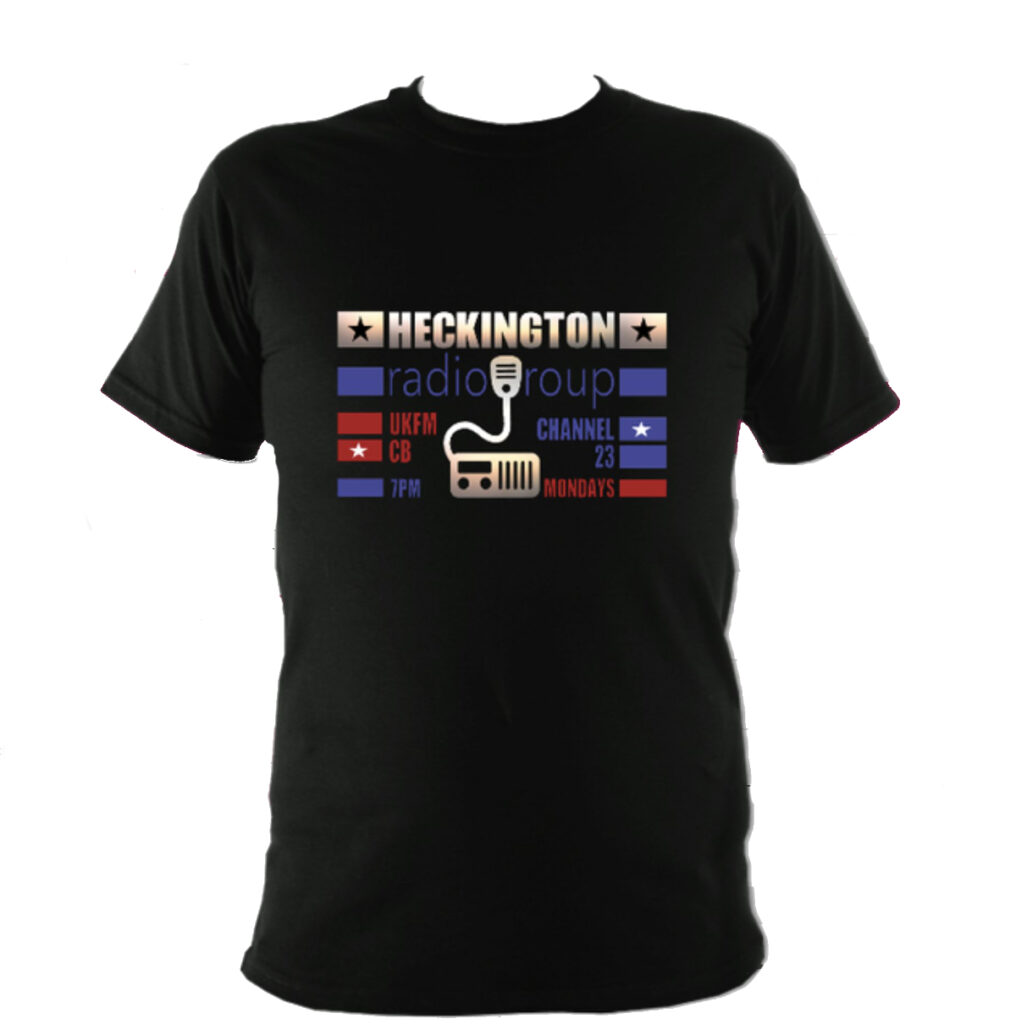The easiest way to begin your hobby radio journey is probably to start with Citizens Band or ‘CB’ radio. You don’t need a licence and equipment is readily available and reasonably cheap. Whether you’re new to radio, a CB’er or amateur, holding our nets on CB means that everyone can join in. That is is why, at Heckington Radio Group, we’ve made Channel 23 our on-air home.
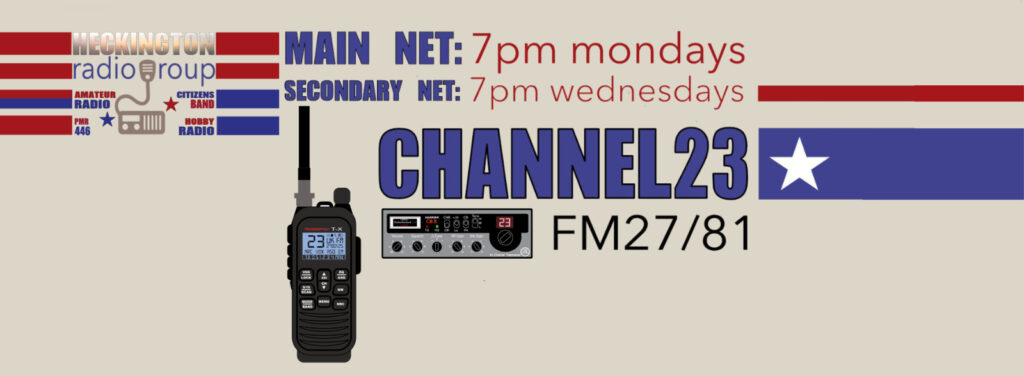
Heckington Radio Group is a small but growing group of radio users based in and around Heckington in Lincolnshire. The group includes licensed radio amateurs, CB users and listeners. They are all keen to support and encourage you to become radio active (no, not THAT kind of radio active!).
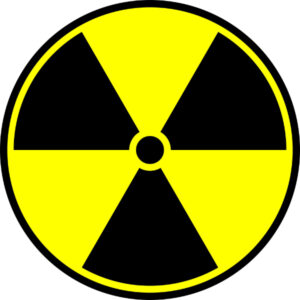
At Heckington Radio Group we chat on air most days and meet up on Monday evenings (primary net) and Wednesday evenings (secondary net) at around 7pm. Everyone is welcome.
Although we use radio as our ‘social media’ you’ll also find us on Facebook:-

We’re serious about radio and can help you into the hobby
Using CB radio, doesn’t mean we’re not serious about radio. We’ve already trained our first Foundation licensee and we’re presently training another. Ultimately, we hope that you too will become a fully fledged radio amateur. But that’s up to you. We will make you welcome at Heckington Radio Group, whatever your interest in radio.
So, why not dip your toe in the radio waters and join us?
Our Simple Guide to CB Radio and Beyond
CB radio is a way of communicating with other users, not by text or by using the internet, but by radio. CB first became popular in the UK in the 1970s. People use radios or ‘rigs’ to chat with their friends and others, potentially across the world. It was, in many ways, an early form of ‘social media’ and many people who lived through the 1970s and 80s will remember the fun they had on CB radio.
From the 1990s, CB went into decline, mostly due to the internet and other, text-based forms of social media. But in the 2020s it began to make a come back. Perhaps this was due to people becoming fed up with Facebook etc. Perhaps it is nostalgia for a different time. Either way, there are increasing numbers of people coming on, or back on to CB radio.
What sort of radio do I need?
There are five main options:-
OPTION 1 – Dig out that 1980s CB Radio!
If you were on CB in the 1980s, perhaps you have an old rig in the garage or loft? Providing it still works, you could use it. However, 40 years is a long time. Radios have components in them called ‘capacitors’ and these can, over time, leak and become faulty. So get someone to check your radio over for you (HRG can help with this).
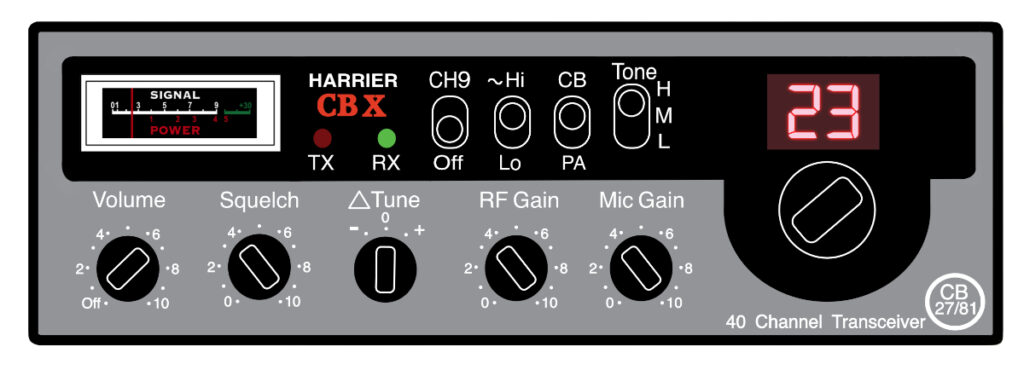
You can also buy a used 1980s radio. Perhaps you have a favourite model from back in the day? Relive your youth with a 1980s rig!
You can find used radios on auction sites and some radio shops (like Knights). Prices range from £30 upwards. But be careful, few such radios haven’t been fiddled with by a so-called ‘screwdriver expert’, so buy from a reputable source and a seller who tells you that the radio is in full working order and preferably serviced by a competent person.
What’s the plus?
Many of these radios are still great performers, if they are working well, and using them will certainly give you that 80s feel.
What’s the downside?
1980s radios only have 40 channels. But we now have a second block of 40 channels used by much of the rest of the world (sometimes called the ‘CEPT’ channels). You won’t be able to access those on a 40 Channel rig marked CB 27/81.
These rigs are also FM only. Nowadays we can also use AM and SSB (or ‘sideband’). FM is good for local contacts but not so good for long distance (‘DX’). SSB is much better for that. AM is an added bonus. But if you are starting out and want to dip your toe in, before committing to a more expensive rig, a 1980s 27/81 FM rig is a reasonable place to start.
You can find out more about 1980s CB radios here.
OPTION 2 – A Modern 80 Channel Rig
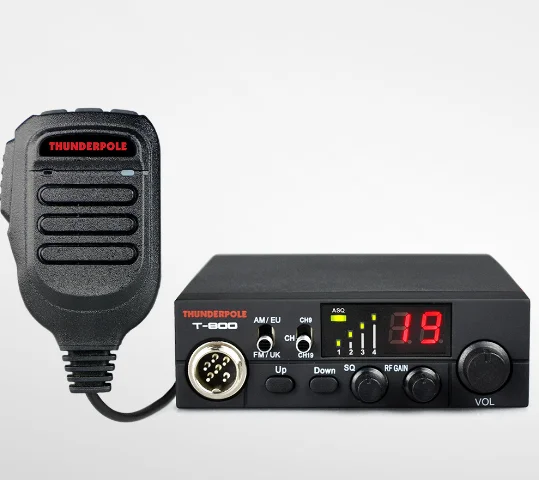
These are the modern equivalent of a 1980’s classic and operate in a very similar fashion. You want one with 80 channels (the UK 40 and the European or ‘CEPT’ 40) and most will also have AM. They mostly have the same power (4 watts) so won’t get you any further, but they will give you wider options. Prices start at around £65.
Thunderpole T-800
What’s the plus?
You get a reliable, 80 Channel rig with 80 channels and AM and FM, which should give years of good service.
What’s the downside?
You may feel that they don’t give you quite that same feeling of nostalgia and you’ll still be a bit limited in range. If you want to work DX you really need a multimode rig that has SSB.
OPTION 3 – A Modern Multimode Rig
Now you’re getting serious! These rigs typically have more power, AM, FM, SSB and both the UK and CEPT 40 Channels, and often many more extra channels.
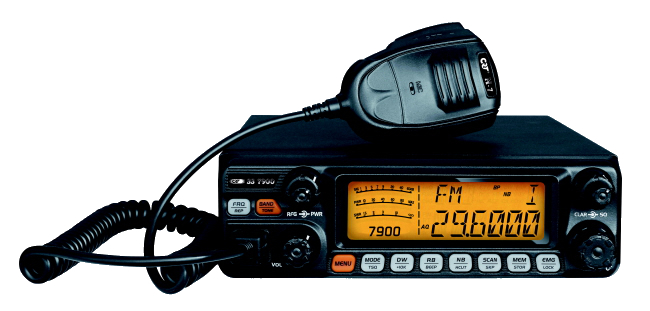
What’s the plus?
With one of these bad boys, a good antenna and when conditions are right, you’ll be able to talk to people around the world! Modern radios are generally sensitive (meaning you’ll hear more) and reliable (many years service if you treat them right). New modern multimodes retail for around £200 upwards.
CRT 7900
What’s the downside?
SSB radios are more complicated to operate. It’s not too difficult, once you get used to them. But there is some learning involved.
Many of these rigs are not legal in the UK. They have too much power and channels that are not approved for use in the UK. That’s why you’ll sometimes see them advertised as ‘export’ radios. They can often also cover a couple of the amateur radio bands and may be set to do that as their default, so may need programming.
While you are very unlikely to get into trouble for using most of the extra CB channels on these rigs (it has been many years since anyone was prosecuted), you MUST NOT transmit on the amateur bands without an amateur licence and to do so may get you into a whole heap of trouble (we can help to explain where you can and can’t go).
OPTION 4 – A handheld CB Radio
Handheld CB radios have come on leaps and bounds since the 1980s. Nowadays, they often have at least 80 channels (both the UK FM and CEPT bands) and both AM and FM. The new T-X from Thunderpole is widely regarded to be the best CB handheld ever made. It retails at around £100. They are rechargeable from a USB port so there is no more changing AA batteries!

What’s the plus?
They are handheld so you can take them with you when out walking the dog or going for a jog. There are no wires, and no antennas to buy when used like this.
For very local contacts, they are great and in exceptional conditions you can even talk to people further afield. With an adapter, an external speaker microphone and antenna, you can use them in the car too! They are very versatile.
What’s the downside?
Used as a handheld with a ‘rubber duck’ (the flexible antenna they come with), be aware that under normal conditions they have VERY LIMITED range. In towns, perhaps 1 or 2 miles at best, so if you live in an area where there are no CB’ers you won’t hear anything from home. In open country side, the range will be a little better and from a hill top, even better. Be aware also that within a big village like Heckington, there may be ‘blackspots’ where people may not be able to hear you.
Handhelds are great for what they are and the T-X is a marvellous radio but, used as a handheld, you probably won’t be talking to people in the next town.
OPTION 5 – A Multiband Amateur Radio
If radio turns out to be your thing then it won’t be long before you want to listen to much more than simply CB or 11m. And, if you obtain your amateur radio licence (see later), you’ll be able to transmit on a whole host of bands across the radio spectrum. So you’ll soon be wanting a radio that covers a wider spectrum.
Amateur radio multi-band transceivers (radios that can transmit and receive) typically cover the whole HF (1-30MHz) or VHF/UHF (above 30MHz) spectrum and some cover both.
Radios by Yaesu, Icom and Kenwood (and some others) are typically much better quality than those built for solely for CB and include many more advanced features. They also have a price tag to match, with some costing over £1000. It is beyond the scope of this guide to cover them in detail but a used radio may be within your budget. Ask for advice before investing your hard earned cash!
OK, so what should I get?
That depends on your budget and what you want to do with your radio. If all you’re interested in is talking to friends very locally and you don’t want an external antenna, then a handheld may do the trick but you won’t be able to talk to people more than a couple of miles away. If you’re into nostalgia and would be happy talking around, say, a 10-30 mile radius (depending on your antenna) then a 1980s FM only rig will be fine. But, if you want to speak to the world and chase DX on SSB then you need a multimode.
What about antennas?
Unless you’re going for a handheld, probably the most important part of your CB setup will be your antenna or ‘twig’. CB operates on a frequency of 27MHz, at a wavelength of around 11m. The best antennas will be around half or 5/8 this wave length, i.e. over 15 feet tall. These are fairly big antennas and not everyone will want or be able to have something that big.
Antennas can be smaller, right down to the size of a rubber duck antenna (typically attached to a handheld radio). But the smaller you go, the less well your antenna will receive and transmit signals. On CB, bigger is always better. But there are some compromises. Here’s a very general and simple guide.
The rubber duck
Good for handhelds only. Range is severely limited, probably to no more than a couple of miles at best. If there is nobody on CB within that area then you probably won’t hear or be able to speak to anyone. So only go for an antenna like this on a handheld radio if you don’t mind being limited to very local contacts.
The mobile whip
Mainly used on vehicles. There are various ways of mounting such antennas, most commonly the ‘mag mount’ which is held on to the body of your vehicle by a strong magnet. Whips can be short or long – as is always the case on CB, the longer the better. But do keep low bridges in mind!
You can also use a mobile whip and mag mount at home if you happen to have a tin roof on a low building, for example. Range won’t be great but it will be a couple of times that of a rubber duck.
The short base station antenna
These antennas are short – starting at about 4ft tall. You should mount them on a pole and as high up as possible, although limited results can be obtained at about 8-10ft off the ground. Range will still be limited to a few miles at best. Again, the longer/taller and higher up you can get them, the better.
The loaded quarter-wave antenna
This antenna can be pole mounted or mounted in some loft spaces. They are about 1m long. Again, range will be limited to around 5 miles. But they will be better outside than in a loft, because of the attenuation caused by your roof tiles.
The half wave and 5/8 ‘Silver Rod’ style antennas
These antennas start at about 5.5m and are by the best budget antenna for beginners. They are pole mounted and benefit from being as high up as possible, but can be mounted on a lower pole 8-10 feet from the ground with moderate success. High up on a roof top they will perform well, enabling 20-30 miles range and worldwide coverage coupled to a multimode rig under optimum conditions. If you possibly can, this should be your starting point.
The 5/8 wave version, which is longer, is even better.
These antennas are typically fairly cheap, coming in at around £40-60.
Better quality antennas
There are many different makes and models of superior CB antenna – far too many to cover here. But if you are in the market for a great antenna, consider the Solarcon Antron 99 antenna. At 18feet, they are not small. They retail for around £130. With one of these and a multimode radio, you will be able to work the world on a good day.
The home brew dipole and other antennas
If you are on a tight budget or just like to make things yourself, it is perfectly possible to make what is called a ‘dipole’ antenna. These are generally made from lengths of wire and are either hung between trees or masts.
There are many kinds of antennas you can build yourself and lots of guidance, plans and ideas available on the internet. Just google “home brew antennas for CB” or ask us for advice.
What else do I need?
A power supply

For most radios, other than a handheld, you’ll need a power supply which converts mains electricity down to the 12v or so that most CB radios require.
For a 4 watt radio you will need a power supply with a minimum of 3amps. These are generally quite cheap to buy, at around £25.
For a multi mode you’ll need more amps – up to 25 or 30 amps for a radio capable of 100w. They cost around £130. Ask an experienced operator or a reputable retailer to recommend the right power supply for your needs.
An SWR meter
It is vital that your antenna is exactly the right length. Most will be pre-tuned, but they might still need some adjustment. If they are out of tune, some of the power that your radio transmits will go up the cable to your antenna but won’t be radiated. Instead, it will come back down the cable and into your radio causing components in your radio to overheat. Too much heat and your radio will be permanently damaged.
This can also happen if there is a fault in the cable or connectors. So you need a means of measuring how much of that signal is coming back down the cable and for that you need what is known as an “SWR meter”. Some radios have these built-in but SWR meters start at around £20, so it is well worth getting one.
The cable to your antenna
You need to use a special kind of cable to take the signal from your radio to the antenna and to bring received signals back. This is called coaxial cable or ‘coax’. There are many different kinds but the one to go for, unless you have a very long run of more than 50m is called “RG58” or “RG58 Mil Spec” (which is usually slightly better). You’ll need the right kind of connectors on both ends. Don’t skimp on coax cable or connectors – get the best quality you can, from a reputable source. With poor coax cable you’ll lose more of your signals and poor connectors can cause high SWR.
Microphones
New radios will come with a microphone but if you are buying second hand, make sure that a mic is included. You can buy better microphones later if need be. But generally the standard microphone will do perfectly well.
What about interference?
Back in the 1970s and 80s, CB could cause no end of interference, mostly to domestic TVs (known as ‘TVI’). However, now that domestic TV has become digital, interference is much less likely. However, high power CB can still cause interference to others, more often to FM radio, HiFi Systems and other electronic devices (like doorbells). To minimise the risk of causing a nuisance to your immediate neighbours try to locate your antennas as high up and away from other antennas and dishes as you can.
If a neighbour tells you about interference, take this seriously but don’t panic! The interference might not be coming from you. One way to confirm this is to keep a log of your radio use and ask your neighbour to make a note of the times and days when the interference happens. If the interference happens when you’re not transmitting then you cannot be causing it!
If you are causing it, then try moving your antenna if you can
Or try using lower power. Sometimes, you can solve interference problems by fitting a ferrite ring on the cables leading to the affected device. Ask Heckington Radio Group for help if you’re not able to resolve the interference. Be as helpful and friendly as you can be as it really won’t do you any favours to fall out with your neighbour. It can help to explain what you’re doing. Try to dispel any myths they may have heard, back in the day, about CB radio and CB’ers running too much power. Most of us have grown up a little since then!
As well as causing interference, you may also experience interference which appears as noise on your radio and, in the worst cases, blocking out the reception of weaker signals. This can be caused by a wide range of electronic and mechanical devices, including broadband routers, power line networks, cheap phone chargers, LED lightbulbs and solar panels and converters. There are a number of steps you can take to minimise this including fitting ferrite rings on your coax and power cables. Ask for help if this becomes a problem for you.
What will I hear?
It is not the 1980s and, while CB is making a comeback, there are nowhere near as many people on CB as there was back then. In some localities there may be nobody at all using CB so, if you have an FM only radio, you may not immediately hear anyone. If that is case, talk to your friends and get them on CB too! That is what we did in Heckington and now we have a small and growing group of regular users.
Remember, if you limit yourself to FM only, and especially with a handheld, this is likely to be an issue and you may be disappointed with your new toy!
Be aware too that there are still bucket mouths (people whose language and attitude leaves a lot to be desired), music players, and people who seem to enjoy spoiling everybody else’s enjoyment of radio. This was a problem back in the 1980s and it remains so. However, these idiots are in the minority and, here at Heckington Radio Group, we pride ourselves on good, friendly operating.
Unlike amateur radio, CB is licence free and anyone can use it (which is one of it’s strengths). But this means that it attracts all sorts of people. If you’re talking to people you don’t know, be careful about your personal security. Don’t give out too many personal details (where exactly you are, what gear you have, the fact that you may live alone etc).
Meeting up with people you don’t know (‘eyeballs’) may have been fun when you were 16, but if you come across a badun’ may not be quite so much fun now! That said, CB is a great hobby through which you will make new friends and have a lot of fun. Just be careful out there!
What is ‘PMR’?
This is a different kind of licence free personal radio, on a much higher frequency (446MHz) where the antennas are smaller. It is channelised, very low powered and intended for very local contacts only. You may legally use one of the cheap PMR handhelds you will find at Argos and other popular retailers. This can be an interesting branch of the radio hobby but it is often used by children who like to play with a ‘walkie talkie’.
As with 27MHz CB there are lots of radios that operate beyond PMR446 but unless you’re a radio amateur such use is not legal. You’ll see radios by manufacturers such as BaoFeng sometimes advertised as ‘multi band’ or ‘dual band’, which give more power and enable access to the PMR446 channels. But their use omy not be legal. Operating in some bands may interfere with other, legal users like the armed forces or aviation. Do that and you may receive an unwelcome knock on the door. So be careful and stay within the legal band on PMR446, especially while you are learning the ropes
What about amateur radio?
If you get bitten by the radio bug, you could move on to Amateur Radio, also known as ‘Ham Radio’. This is not licence free. You have to study a course and pass an exam to obtain a licence. But there are three stages, beginning with the Foundation licence which is relatively straight forward to pass. Armed with your amateur radio licence, you will have access to many more bands, across the radio spectrum and be able to talk to the many radio amateurs around the world. We have several radio amateurs in the Heckington Radio Group, so ask them about this if you are interested.
Whatever you decide, enjoy your radio! It is a great hobby with lots of fun to be had and fascinating possibilities. This introduction is just the start, so welcome to hobby radio!
